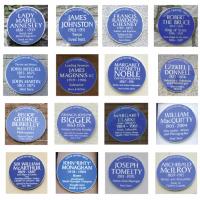Achievers celebrated— 30 years of the Ulster History Circle
Published in
20th-century / Contemporary History,
Features,
General,
Issue 1(Jan/Feb 2013),
Volume 21

A selection of blue plaques celebrating bishops, boxers, poets, inventors, war heroes, patriots, artists, actors, and one fourteenth-century king. (Ulster History Circle)
In the early 1980s, James Hawthorne recognised that there was no collective way to celebrate the achievements of people who had made a significant contribution to Ulster’s heritage. His inspiration founded a scheme to commemorate such individuals by erecting a plaque linking them to a location in their lives. For a body concerned with dates and people, it is paradoxical that the Circle has no exact date for its formation. Hawthorne died in 2006, and with him went this information. The first plaque was on Stranmillis Road in Belfast, to the artist William Conor, at his former studio. Interestingly, this initial plaque carries the name of Belfast City Council, which provided the funding, rather than the name of the Circle.
From its inception, the Circle has been an entirely voluntary, not-for-profit organisation. Unlike English Heritage, which employs a considerable team to manage its London plaque scheme, the Circle has no paid staff but relies on the expertise of members to manage its affairs. The membership of fourteen is a busy working group, and the amount of work they do represents a value to the Circle estimated at tens of thousands of pounds per annum. As well as erecting plaques, the Circle is involved in a number of related and complementary activities, including the development and maintenance of the Dictionary of Ulster Biography (DUB) and the publication of a Guide to Blue Plaques, launched in June 2011. By the end of that year 29,000 copies had been distributed by way of the Libraries NI network, tourist offices and information points, museums, local history societies, and at Circle events and talks. The DUB is an on-line undertaking (www.ulsterbiography.co.uk) which includes all the entries from Kate Newmann’s 1993 dictionary, supplemented by further biographical entries, written mostly by members of the Circle. The dictionary is an entirely free facility, is fully searchable and contains almost 2,000 entries.
In 2007 a grant of £49,200 from the Heritage Lottery Fund in Northern Ireland enabled the Circle to erect 50 blue plaques, establish and maintain the on-line dictionary, develop a comprehensive outreach programme, design and publish the Guide, and contribute to tourism development and promotion by its activities. Local authorities, individuals and organisations also fund the Circle’s plaque programme. Many council districts in Northern Ireland understand the value of having the Circle’s plaques in their area, as a means of promoting heritage tourism and as an inspiration to communities who can take pride in having a celebrated achiever from their locale. Belfast City Council has awarded funding for sixteen plaques throughout the period 2012–15.
To be eligible for a plaque, a person has to be dead for a minimum of twenty years. This period of reflection answers such questions as ‘Why don’t you have a plaque to George Best?’, and of course the on-line DUB can include an entry for a person recently deceased. Other criteria are association with the province of Ulster through birth, education, work or vocation, and having made a significant contribution to the development or delivery of education, industry, commerce, science, arts and literature, politics, international affairs or other field, in Ulster or anywhere in the world. An existing memorial, such as a statue or a named building, usually precludes a person from a plaque. To date, all Circle plaques are in Northern Ireland, but it is hoped that, subject to funding, the plaque scheme will extend in 2013 to the other third of Ulster, counties Donegal, Cavan and Monaghan. The public are encouraged to submit names for discussion, and all suggestions are considered that meet the basic criteria. When accepted for selection, and with funding in place, detailed research is carried out into the surviving addresses of candidates, to ensure that the plaque goes on the correct building. The Circle likes to place a plaque on a birth house, or any suitable replacement building on the same site. Alternatively, or for someone born outside Ulster, the most suitable place of education, residence or work is chosen, and usually a plaque must be visible from the public highway.
After a proposal is accepted, it can take a year or more before a plaque is erected. The Circle has a long waiting list but is eager to have a wider representation of plaques outside the greater Belfast area. On the Circle’s website at www.ulsterhistory.co.uk all the plaques have an entry offering information about the individual commemorated and the plaque location. There are bishops, boxers, poets, inventors, war heroes, patriots, artists, actors and one fourteenth-century king amongst those whose achievements are celebrated. In early 2013 plaques will go up to Sir Otto Jaffe, philanthropist and Belfast’s first Jewish lord mayor, Seán Lester, secretary-general of the League of Nations, and John Clarke, innovative potato-breeder from north Antrim. The Circle is also planning a special leaflet for a plaque trail in Derry, in the City of Culture year.
Over the last 30 years the blue plaques have become an accolade both sought after and commended. The 150th plaque will soon be unveiled as the work of the Ulster History Circle continues, ensuring that the history and heritage of Ulster have a bright future to celebrate. HI

















